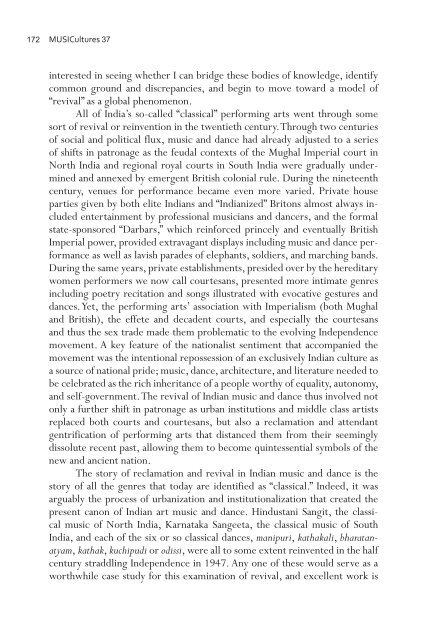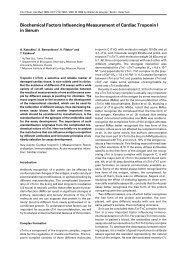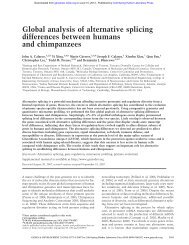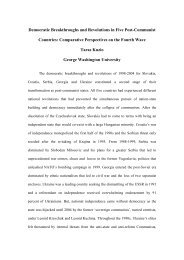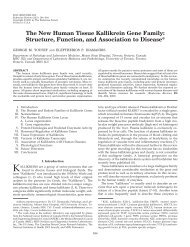revival and reinvention in india's Kathak dance - University of Toronto
revival and reinvention in india's Kathak dance - University of Toronto
revival and reinvention in india's Kathak dance - University of Toronto
You also want an ePaper? Increase the reach of your titles
YUMPU automatically turns print PDFs into web optimized ePapers that Google loves.
172 MUSICultures 37<strong>in</strong>terested <strong>in</strong> see<strong>in</strong>g whether I can bridge these bodies <strong>of</strong> knowledge, identifycommon ground <strong>and</strong> discrepancies, <strong>and</strong> beg<strong>in</strong> to move toward a model <strong>of</strong>“<strong>revival</strong>” as a global phenomenon.All <strong>of</strong> India’s so-called “classical” perform<strong>in</strong>g arts went through somesort <strong>of</strong> <strong>revival</strong> or <strong>re<strong>in</strong>vention</strong> <strong>in</strong> the twentieth century. Through two centuries<strong>of</strong> social <strong>and</strong> political flux, music <strong>and</strong> <strong>dance</strong> had already adjusted to a series<strong>of</strong> shifts <strong>in</strong> patronage as the feudal contexts <strong>of</strong> the Mughal Imperial court <strong>in</strong>North India <strong>and</strong> regional royal courts <strong>in</strong> South India were gradually underm<strong>in</strong>ed<strong>and</strong> annexed by emergent British colonial rule. Dur<strong>in</strong>g the n<strong>in</strong>eteenthcentury, venues for performance became even more varied. Private houseparties given by both elite Indians <strong>and</strong> “Indianized” Britons almost always <strong>in</strong>cludedenterta<strong>in</strong>ment by pr<strong>of</strong>essional musicians <strong>and</strong> <strong>dance</strong>rs, <strong>and</strong> the formalstate-sponsored “Darbars,” which re<strong>in</strong>forced pr<strong>in</strong>cely <strong>and</strong> eventually BritishImperial power, provided extravagant displays <strong>in</strong>clud<strong>in</strong>g music <strong>and</strong> <strong>dance</strong> performanceas well as lavish parades <strong>of</strong> elephants, soldiers, <strong>and</strong> march<strong>in</strong>g b<strong>and</strong>s.Dur<strong>in</strong>g the same years, private establishments, presided over by the hereditarywomen performers we now call courtesans, presented more <strong>in</strong>timate genres<strong>in</strong>clud<strong>in</strong>g poetry recitation <strong>and</strong> songs illustrated with evocative gestures <strong>and</strong><strong>dance</strong>s. Yet, the perform<strong>in</strong>g arts’ association with Imperialism (both Mughal<strong>and</strong> British), the effete <strong>and</strong> decadent courts, <strong>and</strong> especially the courtesans<strong>and</strong> thus the sex trade made them problematic to the evolv<strong>in</strong>g Independencemovement. A key feature <strong>of</strong> the nationalist sentiment that accompanied themovement was the <strong>in</strong>tentional repossession <strong>of</strong> an exclusively Indian culture asa source <strong>of</strong> national pride; music, <strong>dance</strong>, architecture, <strong>and</strong> literature needed tobe celebrated as the rich <strong>in</strong>heritance <strong>of</strong> a people worthy <strong>of</strong> equality, autonomy,<strong>and</strong> self-government. The <strong>revival</strong> <strong>of</strong> Indian music <strong>and</strong> <strong>dance</strong> thus <strong>in</strong>volved notonly a further shift <strong>in</strong> patronage as urban <strong>in</strong>stitutions <strong>and</strong> middle class artistsreplaced both courts <strong>and</strong> courtesans, but also a reclamation <strong>and</strong> attendantgentrification <strong>of</strong> perform<strong>in</strong>g arts that distanced them from their seem<strong>in</strong>glydissolute recent past, allow<strong>in</strong>g them to become qu<strong>in</strong>tessential symbols <strong>of</strong> thenew <strong>and</strong> ancient nation.The story <strong>of</strong> reclamation <strong>and</strong> <strong>revival</strong> <strong>in</strong> Indian music <strong>and</strong> <strong>dance</strong> is thestory <strong>of</strong> all the genres that today are identified as “classical.” Indeed, it wasarguably the process <strong>of</strong> urbanization <strong>and</strong> <strong>in</strong>stitutionalization that created thepresent canon <strong>of</strong> Indian art music <strong>and</strong> <strong>dance</strong>. H<strong>in</strong>dustani Sangit, the classicalmusic <strong>of</strong> North India, Karnataka Sangeeta, the classical music <strong>of</strong> SouthIndia, <strong>and</strong> each <strong>of</strong> the six or so classical <strong>dance</strong>s, manipuri, kathakali, bharatanatyam,kathak, kuchipudi or odissi, were all to some extent re<strong>in</strong>vented <strong>in</strong> the halfcentury straddl<strong>in</strong>g Independence <strong>in</strong> 1947. Any one <strong>of</strong> these would serve as aworthwhile case study for this exam<strong>in</strong>ation <strong>of</strong> <strong>revival</strong>, <strong>and</strong> excellent work is


